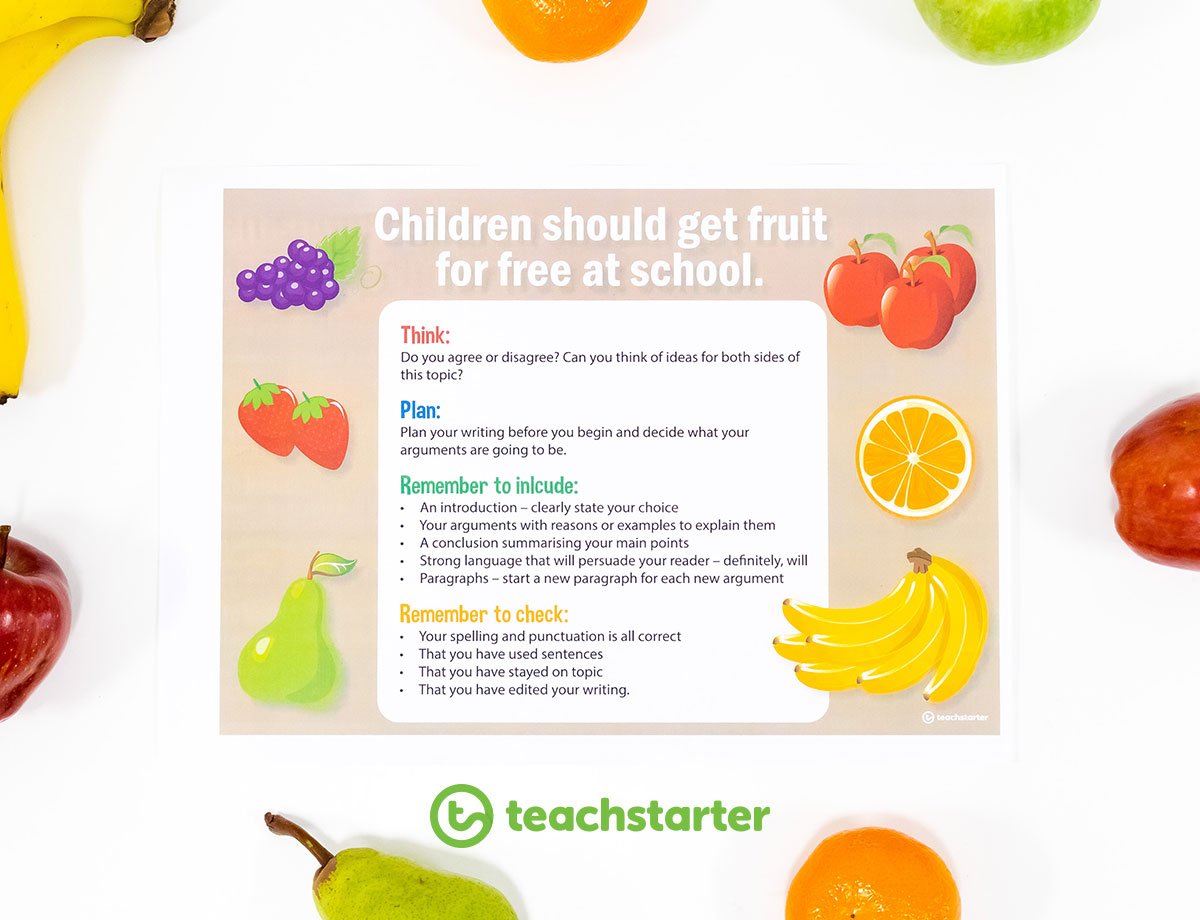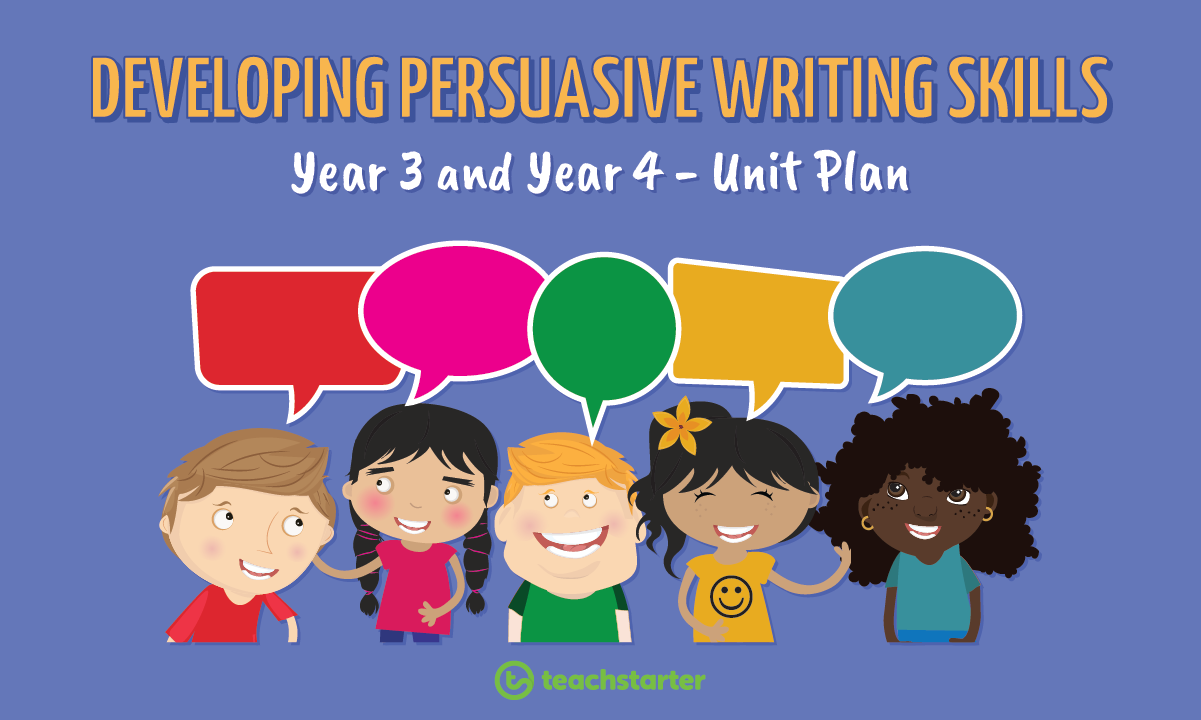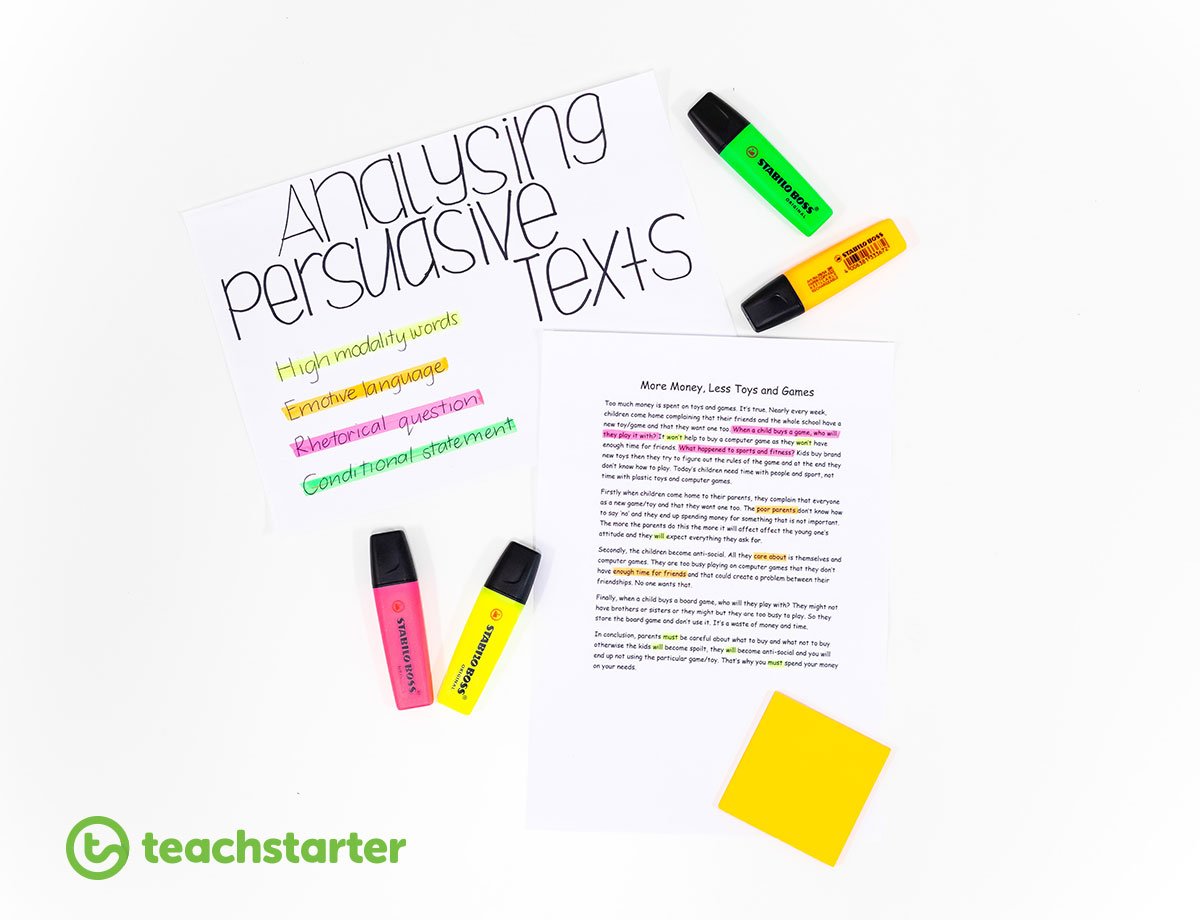Teaching persuasive writing is common practiceacross all year levels in our school system, and there’s good reason why.
If you look carefully, you’ll notice that persuasive texts are everywhere in society; real-life applications include expositions, discussions, letters to the editor, debates, reviews and advertisements.
By teaching this text type effectively and facilitating its mastery, we prepare our students not only for future learning, but for life in a world where opinions are everywhere.
I recently had the pleasure of working as a specialist writing teacher. I loved teaching persuasive writing to groups of Year Three students, and I’d like to share with you some of the ways I did this!
If you’re about to begin teaching a unit on persuasive writing, take a browse through our Persuasive Writing Resource Collectionfor informative, curriculum-aligned resources and plans.
But first, let’s take a look at the many different ways you can explore persuasive writing with your students!
Purely Persuasive
Education consultant and author Dr Anita Archerrecommends that teachers focus on a limited number of genres (also known as text types) at a given time. Many schools plan to teach one text type per term. This helps students to gain a thorough understanding of one text type before moving on to another.
By focusing solely on persuasive writing for the duration of your unit, you give your students the time they need to develop and hone their skills.
Our Persuasive Writing Skills PowerPoint is a great initial introduction to your unit, and can also be used as a daily or weekly warm-up exercise with your class! Here’s a little preview (you’ll definitely want to download it!)
Start With Structure
[resource:264755][resource:26218][resource:24582][resource:2126]
One of the things that differentiates text types from one another is their generic structure. A fundamental starting point in teaching persuasive writing is teaching its individual structure.
As students progress through year levels, we build upon previous knowledge about persuasive structure to include more complex ideas.
OurPersuasive Text Structure Lesson Plan is 60 minutes of goodness for introducing students to the standard structure of persuasive texts.
The lesson also contains this great video which concisely introduces persuasive writing:
Sequencing Activities for Persuasive Texts
Sequencing activities are a fun, hands-on way to reinforce students’ understanding of the generic structure of persuasive texts.
We have heaps of printable resources for you to use with your class. These would be perfect to incorporate into your literacy rotations as they don’t take very long to complete – but kids love them!
[resource:24499][resource:24493][resource:24480][resource:24533]
Use Explicit Instruction When Teaching Persuasive Writing
“Writing is not caught. It is taught.” – Dr Anita Archer
We don’t become great writers by osmosis. All learners must be explicitly taught the skills and given the tools necessary to produce completed pieces of writing.
Explicit instruction is considered current best practice, and all of our resources reflect this.
ItsI do(teacher modeling),we do(guided practice) andyou do(independentpractice) process certainly applies to teaching persuasive writing. It’s important to provide students with ample opportunities for writing, as well as a balance of modelled, guided and independent writing.
Our unit plan collection contains these excellent persuasive writing resources:
- Exploring Persuasive Texts – Years 1 and 2contains eight 60-minute lessons designed tointroduce the persuasive genre to students; specifically, the purpose, structure and language features of persuasive texts.
- Developing Persuasive Writing Skills – Years 3 and 4contains ten 60-minute lessonsaddressing the genre of persuasion; specifically, how to write a well-structured persuasive text.
Teaching the Persuasive Devices
Any great persuasive writer possesses the tools most likely get the reader agree with them. Persuasive devices are language tools which are crucial to teach your students. Thepersuasive devices are:
- Alliteration
- Rhetorical questions
- Exaggeration
- Statistics
- Emotive language
- Modality
- Repetition
- Facts
- Opinion
- Rule of 3
- Personal pronouns
These devices are all outlined in our Persuasive Techniques Poster Pack.
When I was teaching persuasive writing, I would choose to focus on one device at a time. I’d work through the devices I felt would have the greatest impact, and which were the most simple for the students to grasp. I chose to focus on rhetorical questions, emotive language, modality and conditional statements as a starting point.
I was then able to differentiate by introducing further devices to extend my able students, as well as simplifying or reducing the number of devices for students who required more support.
[resource:17935][resource:197601][resource:199826][resource:7230]
Persuasive Quick Writes
An expectation on young students to complete a persuasive text in one session can seem overwhelming – to the students and the teacher! By scheduling “Quick Writes” (short, sharp writing sessions), your students get to practice their skills regularly.
They could just write an introduction one day, then the first argument the following day, followed by arguments two and three the next day and conclusion on the fourth day. The fifth day of the school week may be used for reflection, editing and conferencing with peers or the teacher.
Quick Writes help students pace themselves so that in timed assessment conditions they are able to manage their time effectively in order to complete the task.
Teaching About Modality
Our Modality Word Wall is a great classroom display to use while teaching persuasive writing.
It is colour-coded which makes it easy for students to distinguish between high-, medium- and low- modality words. It comes with a brief description of each level of modality. When teaching persuasive writing I chose to only display the high modality words, in order to encourage students to choose those over medium or low modality words.
It can also be printed at 50% size and laminated to make a hands-on sorting activity!
[resource:10381][resource:269652][resource:218089][resource:49045]
Persuasive Writing with Passion
Getting kids to understand the purpose of persuasive writing can be simple, but it’s often more difficult for them to write persuasively about something they’re not interested in. While there’s certainly a place for demand-writing to a set topic, it’s also beneficial to allow children to explore topics they’re already passionate about.
Conferencing with students can really draw out some great ideas and ignite interest in our young students. Finding out what they really care about helps us as teachers to help them focus on totally nailing their persuasive writing tasks.
What do your students care about?
Do you have a budding athlete who lives and breathes football? A foodie who loves to cook for her family? A tender heart who loves all creatures great and small? Harness their passions and get them writing!
Equip Students with Persuasive Vocabulary
When we teach students appropriate, extended vocabulary, we enable them to supercharge their writing! When teaching persuasive writing, I like to focus on one difficult or challenging vocabulary word every few days. Exploring the meaning, part of speech, synonyms and antonyms of that word helps to build student’s knowledge of interesting words to use in their writing.
Even if spelling isn’t quite spot on, there is value in students using these words in the context of their writing.
Our newPersuasive Vocabulary Word Wall is full of wonderful words which are suited to teaching persuasive writing.
Set Clear Goals for Persuasive Writing
Learning intentions are teacher-given descriptions of what the student needs to do in order to accomplish a set task. Success criteriaare the measures used teachers in order to determine whether the student has met the learning intentions.
When teaching persuasive writing, being transparent with our students about both of these is critical. This can be achieved in several ways:
- Upon starting the unit, provide an overview of the learning that will take place
- Provide students (and parents, for homework tasks or projects) with a marking rubric or criteria sheet for each assessment task undertaken
- Show students work samples from previous years’ students and from relevant study authorities (and annotate and analyse these together)
- A “What a good one looks like” wall, showing current peer samples at varying assessable levels.
- Give students self-assessment tools and checklists to track their own progress.
Our NAPLAN-style marking rubricis a great teaching resource to show your students to really illustrate what you’re looking for when marking their writing pieces.
[resource:95376][resource:812][resource:48546][resource:24301]
Expose Students to Persuasive Writing in Literature
Or fantastic blog10 Childrens Books For Teaching Persuasive Writinggives some beautiful literary examples of persuasion to explore with your students!













Comments